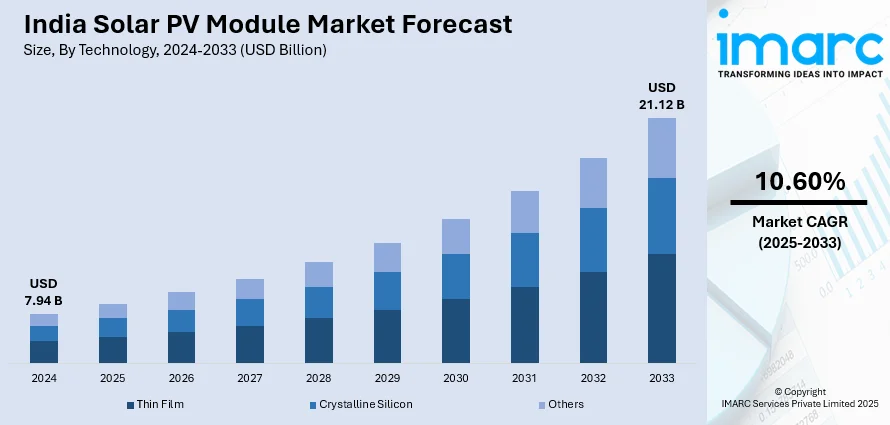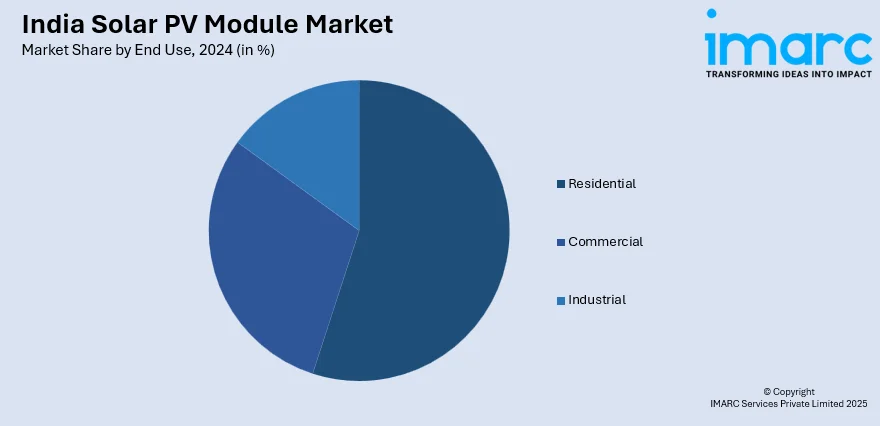
India Solar PV Module Market Size, Share, Trends and Forecast by Technology, Product Type, Connectivity, Mounting, End Use, and Region, 2025-2033
India Solar PV Module Market Size and Share:
The India solar PV module market size reached USD 7.94 Billion in 2024. Looking forward, IMARC Group expects the market to reach USD 21.12 Billion by 2033, exhibiting a growth rate (CAGR) of 10.60% during 2025-2033. India's solar PV module market is growing with increasing demand for high-efficiency modules and rising domestic manufacturing capacity. Moreover, improvements in TOPCon and bifacial technologies and expanding large-scale production are fueling growth, enhancing energy security, and enabling the country's transition to renewable energy.
|
Report Attribute
|
Key Statistics
|
|---|---|
|
Base Year
|
2024
|
|
Forecast Years
|
2025-2033
|
|
Historical Years
|
2019-2024
|
| Market Size in 2024 | USD 7.94 Billion |
| Market Forecast in 2033 | USD 21.12 Billion |
| Market Growth Rate (2025-2033) | 10.60% |
India Solar PV Module Market Trends:
Rising Demand for High-Efficiency Modules
India's solar industry is transforming at a fast pace, with more focus on high-efficiency modules to cater to rising energy demands. Along with this, developers and energy firms are focusing on advanced solar technology to achieve maximum power output, better performance under varied climatic conditions, and long-term sustainability. Furthermore, bifacial, N-type TOPCon, and Glass-to-Glass modules are gaining traction as they provide greater energy yields, superior durability, and improved reliability than traditional models. In January 2025, Waaree Energies secured a 150 MWp solar module order for a major renewable project in India. The company will supply high-efficiency Glass N-type TOPCon bifacial modules, known for their superior performance, durability, and energy output. This is a move towards more technologically sophisticated solar panels with improved efficiency and reliability for use in large-scale renewable energy projects. The increasing adoption of such modules is motivated by advances in cell technology, lower degradation rates, and enhanced resistance to environmental conditions. Concurrently, the developers are making major investments in high-performance modules to achieve higher land utilization, lower operating costs, and overall improved feasibility of solar power projects. Further, this is anticipated to be ongoing as India focuses on increased adoption of solar power, solidifying its renewable energy setup and enhancing the stability of the grid using state-of-the-art solar technology.

To get more information on this market, Request Sample
Expanding Domestic Solar Manufacturing Capacity
India’s solar manufacturing sector is undergoing significant expansion, driven by the push for self-reliance and increased domestic production. With ambitious renewable energy targets, the government and private players are focusing on scaling up module production, reducing import dependence, and enhancing local supply chain capabilities. This shift is crucial for meeting rising solar demand, ensuring cost competitiveness, and supporting the growth of utility-scale and distributed solar projects. In October 2024, Saatvik Solar supplied 450 MW of solar PV modules in Gujarat and confirmed an additional 1 GW supply in the next fiscal year. This expansion reinforces India’s growing manufacturing base, increasing solar module availability for large-scale projects and industrial applications. With further capacity additions planned, domestic production is expected to keep pace with increasing market demand. The expansion of manufacturing capabilities contributes to greater energy security, job creation, and reduced reliance on imported solar equipment. It also enhances India’s position in the global solar supply chain, making it a key player in renewable energy production. As more companies invest in state-of-the-art manufacturing facilities, India is set to achieve higher solar deployment rates, strengthening its clean energy goals while ensuring a stable and competitive domestic module market.
India Solar PV Module Market Segmentation:
IMARC Group provides an analysis of the key trends in each segment of the market, along with forecasts at the region/country level for 2025-2033. Our report has categorized the market based on technology, product type, connectivity, mounting, and end use.
Technology Insights:
- Thin Film
- Crystalline Silicon
- Others
The report has provided a detailed breakup and analysis of the market based on the technology. This includes thin film, crystalline silicon, and others.
Product Type Insights:
- Monocrystalline
- Polycrystalline
- Cadmium Telluride
- Amorphous Silicon
- Others
The report has provided a detailed breakup and analysis of the market based on the product type. This includes monocrystalline, polycrystalline, cadmium telluride, amorphous silicon, and others.
Connectivity Insights:
- On-Grid
- Off-Grid
A detailed breakup and analysis of the market based on the connectivity have also been provided in the report. This includes on-grid and off-grid.
Mounting Insights:
- Ground Mounted
- Roof-Top
A detailed breakup and analysis of the market based on the mounting have also been provided in the report. This includes ground mounted and roof-top.
End Use Insights:

- Residential
- Commercial
- Industrial
A detailed breakup and analysis of the market based on the end use have also been provided in the report. This includes residential, commercial, and industrial.
Region Insights:
- North India
- South India
- East India
- West India
The report has also provided a comprehensive analysis of all the major regional markets, which include North India, South India, East India, and West India.
Competitive Landscape:
The market research report has also provided a comprehensive analysis of the competitive landscape. Competitive analysis such as market structure, key player positioning, top winning strategies, competitive dashboard, and company evaluation quadrant has been covered in the report. Also, detailed profiles of all major companies have been provided.
India Solar PV Module Market News:
- March 2025: RenewSys signed an agreement to supply 72.5 MWp TOPCon Glass-to-Glass solar PV modules to Radiance Renewables. Scheduled for delivery between December 2024 and March 2025, this initiative strengthens India’s solar capacity, enhancing efficiency and supporting the country’s renewable energy expansion.
- February 2025: Central Electronics Ltd (CEL) invited Expressions of Interest (EOI) to outsource its 40 MWp automated solar PV module manufacturing plant in Ghaziabad, Uttar Pradesh. This move enhances domestic production capacity, promotes private sector participation, and strengthens India’s solar manufacturing ecosystem.
India Solar PV Module Market Report Coverage:
| Report Features | Details |
|---|---|
| Base Year of the Analysis | 2024 |
| Historical Period | 2019-2024 |
| Forecast Period | 2025-2033 |
| Units | Billion USD |
| Scope of the Report |
Exploration of Historical Trends and Market Outlook, Industry Catalysts and Challenges, Segment-Wise Historical and Future Market Assessment:
|
| Technologies Covered | Thin Film, Crystalline Silicon, Others |
| Product Types Covered | Monocrystalline, Polycrystalline, Cadmium Telluride, Amorphous Silicon, Others |
| Connectivities Covered | On-Grid, Off-Grid |
| Mountings Covered | Ground Mounted, Roof-Top |
| End Uses Covered | Residential, Commercial, Industrial |
| Regions Covered | Northern Spain, Eastern Spain, Southern Spain, Central Spain |
| Customization Scope | 10% Free Customization |
| Post-Sale Analyst Support | 10-12 Weeks |
| Delivery Format | PDF and Excel through Email (We can also provide the editable version of the report in PPT/Word format on special request) |
Key Benefits for Stakeholders:
- IMARC’s industry report offers a comprehensive quantitative analysis of various market segments, historical and current market trends, market forecasts, and dynamics of the India solar PV module market from 2019-2033.
- The research report provides the latest information on the market drivers, challenges, and opportunities in the India solar PV module market.
- Porter's five forces analysis assist stakeholders in assessing the impact of new entrants, competitive rivalry, supplier power, buyer power, and the threat of substitution. It helps stakeholders to analyze the level of competition within the India solar PV module industry and its attractiveness.
- Competitive landscape allows stakeholders to understand their competitive environment and provides an insight into the current positions of key players in the market.
Key Questions Answered in This Report
The solar PV module market in India was valued at USD 7.94 Billion in 2024.
The solar PV module market in India is projected to exhibit a CAGR of 10.60% during 2025-2033, reaching a value of USD 21.12 Billion by 2033.
The growth of the India solar PV module market is driven by government policies supporting renewable energy, such as the National Solar Mission, which aims to achieve ambitious solar capacity targets. The growing requirement for sustainable and cost-effective energy solutions also contributes significantly. Furthermore, advancements in solar technologies, including improvements in module efficiency and energy storage, continue to make solar power more attractive to consumers and businesses.
Need more help?
- Speak to our experienced analysts for insights on the current market scenarios.
- Include additional segments and countries to customize the report as per your requirement.
- Gain an unparalleled competitive advantage in your domain by understanding how to utilize the report and positively impacting your operations and revenue.
- For further assistance, please connect with our analysts.
 Request Customization
Request Customization
 Speak to an Analyst
Speak to an Analyst
 Request Brochure
Request Brochure
 Inquire Before Buying
Inquire Before Buying




.webp)




.webp)












